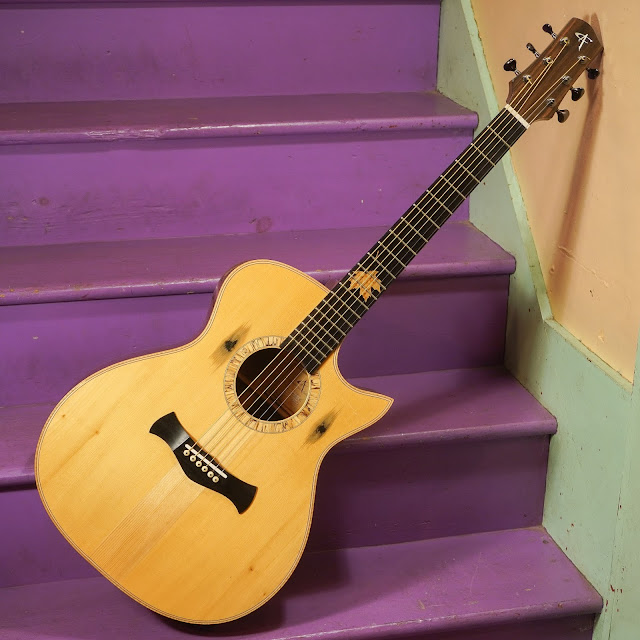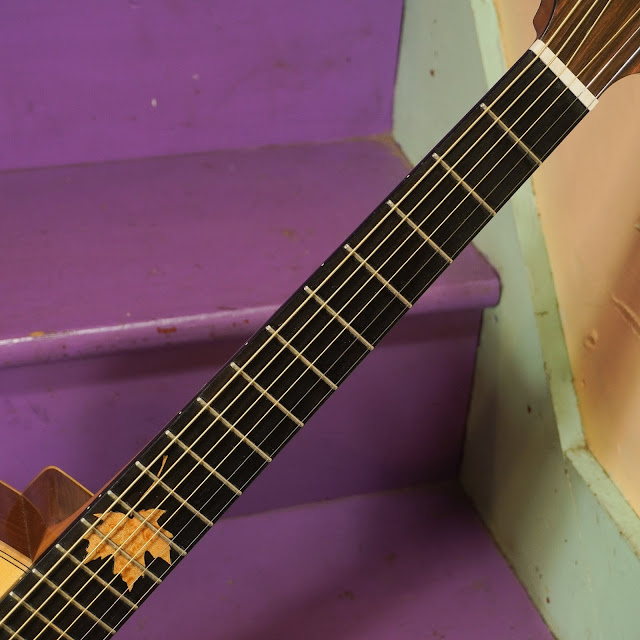2011 Craig Anderson A1-C Cutaway Mini-Jumbo Guitar
Craig Anderson no longer builds, but when he was building his $4-6k boutique guitars, he was mostly building them in Burlington, VT -- where this one was made. I sold a different Anderson last year and this one is every bit as good. These truly are "boutique" boxes and handle like sports cars -- they're lightweight, huge in tone, and have scalloped bracing that creeps right up to the point just before destruction via normal tension. That's a trait shared with '30s Martins, among others.
This one's an interesting character, too. It appears to have some orangey-red cocobolo rosewood for the back and sides and, as the owner notes, it has salvaged, Civil War-era spruce for the top -- complete with black filled holes from where the spikes (large nails) had been knocked through it when the wood was young. The rest of the trim is fancy, too -- it has a nice walnut neck, ebony board and bridge, flamed maple binding and a wood-inlaid rosette, maple leaf in the fretboard, you name it!
The neck is slim and quick and handles along the lines of a modern Martin or Taylor. It has a curious, almost bajo-quinto-like cutaway horn shape, and there's a dang soundport on the shoulder. I like those -- I used to think they were silly, but enough guitars have come through with them on them as originally-cut or gained them as a result of yanked onboard electronics that I now think of them as a win-win and a perk. You don't lose forward punch or projection but you do gain some joy at being able to hear your instrument perform.
Now, what's wrong with it? Well, not much, really... but! The central portion of the top was replaced (by the maker, presumably) at one point because it was riddled with old spike-holes and had failed at the damage points, apparently. I've seen it this way over the last few years and it's been stable and good to go, so no worries are due because of it. The finish is satin and not pore-filled where that section of top was replaced, however. I kind-of like that it doesn't lie about itself because of that.
Otherwise, the guitar's in good health. I just gave it a glorified setup and adjustments before putting it out on the floor. It has a K&K Pure Mini pickup system installed that sounds excellent.
What kind of player would enjoy this, though? Well, the tone is full, transparent, and lush in the lows. It has creamy mids and trebles that are saturated. I think a fingerpicker would adore it but it makes a great flatpicker, too. It responds right away and doesn't need to be pushed hard at all to get it good sound out of it.
Repairs included: fret level/dress, saddle compensation and adjustment, minor wiring adjustments.
Top wood: solid spruce
Back & sides wood: solid cocobolo rosewood (or similar)
Bracing type: x, scalloped
Bridge: ebony
Fretboard: ebony
Neck wood: walnut
Action height at 12th fret: 3/32” bass 1/16” treble (fast, spot-on)
String gauges: 54w-12 lights
Neck shape: slim D
Board radius: ~14-16"
Truss rod: adjustable
Neck relief: straight
Fret style: medium-bigger
Scale length: 25 3/8"
Nut width: 1 3/4"
Body width: 15 3/4"
Body depth: 4 1/2"
Condition notes: it has a replaced middle section of top that was professionally done either by the original builder or someone very good at it. There's an average amount of pickwear near the soundhole and mild usewear/small scratches throughout. A K&K pickup system was installed. The original bone saddle's intonation was not accurate so I recompensated it and fit a bone shim under it to raise its height for spot-on playability. The original tuners were replaced with fancy Gotoh units and it has extra screw-holes on the back of the headstock. As you'd expect for a lightweight build, the top has minor belly along the lines of an old Gibson behind the bridge. It's been stable for years.
It comes with: a nice TKL hard case.
























Comments